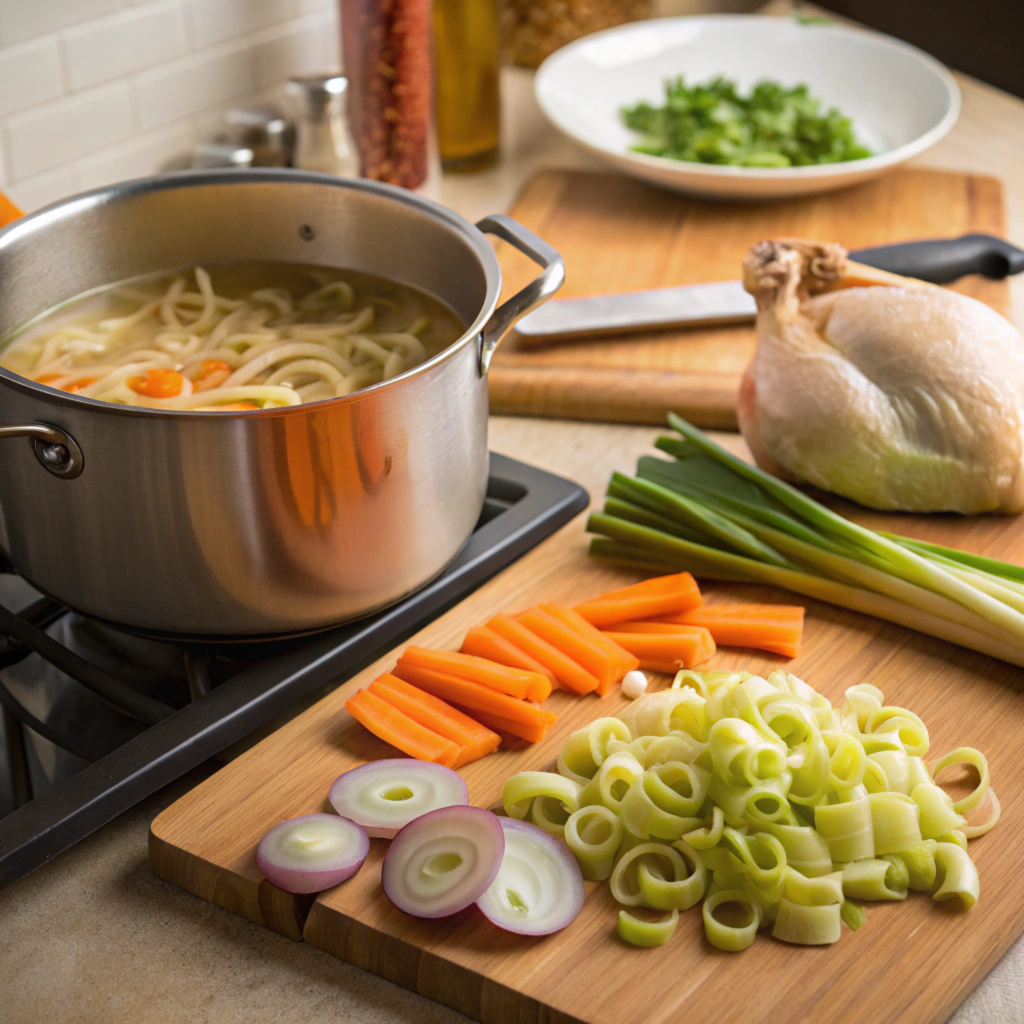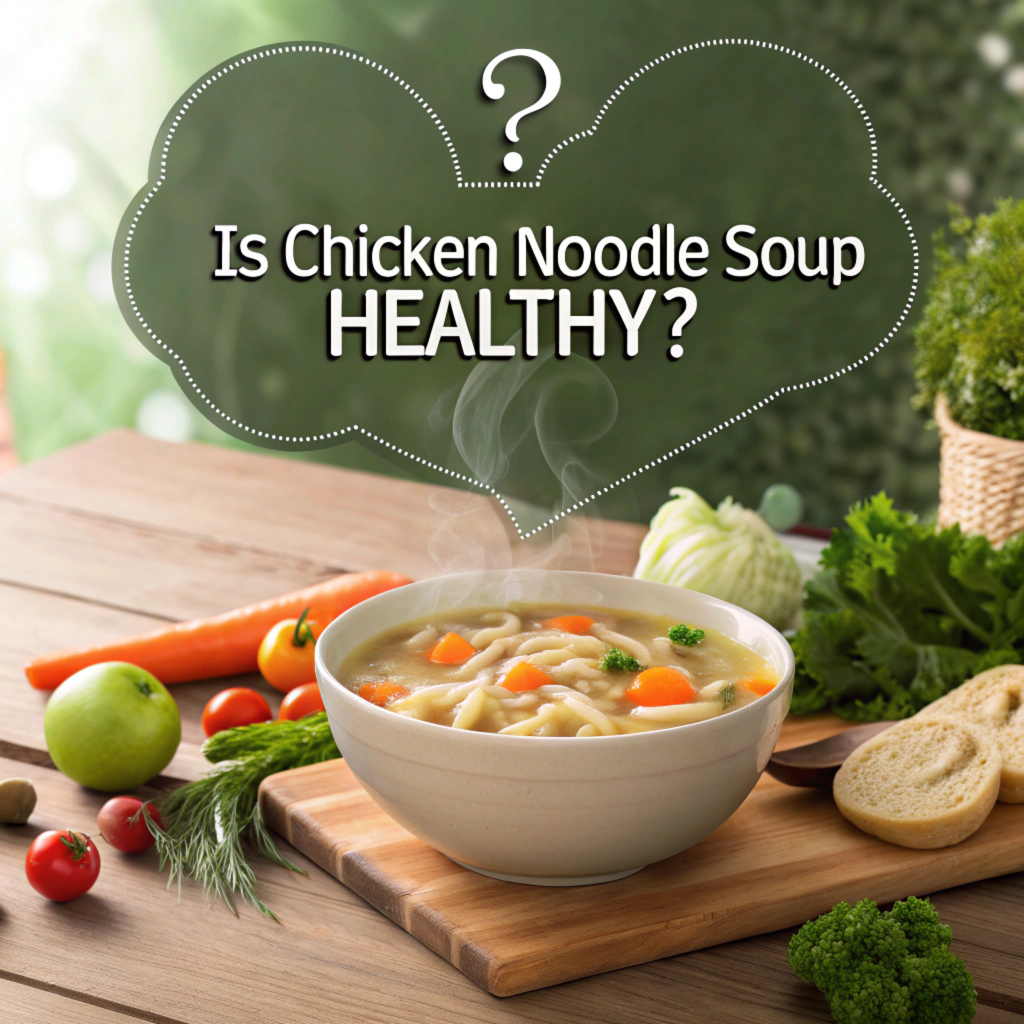
Chicken noodle soup has long been considered a classic comfort food, often associated with cold winter days or times when someone isn’t feeling well. But beyond its reputation as a heartwarming meal, many wonder: Is chicken noodle soup truly healthy? This question arises because its nutritional value can vary depending on how it is prepared. In this article, we’ll explore its health benefits, nutritional components, and tips for making healthier versions at home.
Why Chicken Noodle Soup Is Popular
Chicken noodle soup is beloved for its comforting, warm, and savory taste. Its combination of tender chicken, soft noodles, and flavorful broth creates a dish that is not only satisfying but also emotionally soothing. Historically, this soup has been used in various cultures as a home remedy for colds and flu due to its hydrating and nourishing properties.
Comfort Food with a Nutritional Reputation
Beyond comfort, chicken noodle soup has earned a place in the category of nutritious meals. Its ingredients — chicken, vegetables, and noodles — offer a balance of essential nutrients. Protein from chicken, vitamins from vegetables, and energy-boosting carbohydrates from noodles make this soup a well-rounded dish when prepared thoughtfully. Additionally, the broth helps maintain hydration, making it ideal for those recovering from illness.
Origins of Chicken Noodle Soup as a Healing Meal
The origins of chicken noodle soup date back centuries. It has roots in various global cuisines, including traditional Chinese, Middle Eastern, and European recipes. Chicken has always been considered a source of strength in many cultures, while noodles have provided affordable sustenance. Together, they create a dish that is both economical and nutritious, solidifying its place as a comforting staple worldwide.
Nutritional Breakdown of Chicken Noodle Soup
Chicken noodle soup is considered both comforting and nutritious due to its simple yet healthful ingredients. Understanding its nutritional profile can help determine how it fits into a balanced diet. Let’s explore the key components that make chicken noodle soup a healthy meal choice.
What’s in a Bowl of Chicken Noodle Soup?
A standard serving of chicken noodle soup includes essential ingredients that provide a variety of nutrients. A typical homemade or canned version contains chicken, noodles, vegetables, and a broth base. These ingredients combine to create a nutrient-dense meal that offers protein, fiber, vitamins, and minerals.
Core Ingredients and Their Benefits
1. Chicken: High-Protein Powerhouse
Chicken is a key source of lean protein, which helps build and repair muscle tissue. A standard cup of chicken noodle soup can contain approximately 10-15 grams of protein, depending on the amount of chicken used.
2. Noodles: Energy-Boosting Carbohydrates
Egg noodles or pasta contribute to the soup’s carbohydrate content, providing energy. A serving typically contains about 20-30 grams of carbohydrates, essential for fueling the body.
3. Vegetables: A Source of Vitamins and Fiber
Carrots, celery, and onions — the most common vegetables in chicken noodle soup — are rich in vitamins A, C, and K as well as fiber. These nutrients help boost the immune system, support digestion, and promote overall health.
4. Broth: Hydration and Electrolytes
The broth provides both hydration and electrolytes such as sodium and potassium, essential for maintaining fluid balance. Homemade broth can be even healthier when made with bone broth, offering extra minerals like calcium and magnesium.
Calories and Macronutrients
The caloric content of chicken noodle soup depends on its ingredients and serving size. Here’s a general breakdown:
- Calories: 150-250 per cup (depending on broth and ingredients)
- Protein: 10-15 grams from chicken
- Carbs: 20-30 grams from noodles and vegetables
- Fat: 3-7 grams from chicken and broth
Choosing low-fat or low-sodium broth can significantly reduce the soup’s calorie and fat content.
Vitamins and Minerals
A bowl of chicken noodle soup can be a great source of:
- Vitamin A: Supports eye health and immune function
- Vitamin C: Strengthens the immune system
- Potassium: Helps regulate heart and muscle function
- Iron: Promotes red blood cell production
Final Thoughts on Nutritional Value
Chicken noodle soup can be highly nutritious when made with fresh, wholesome ingredients. Whether you prefer a homemade version or a store-bought option, being mindful of sodium, portion size, and added ingredients can make this comforting meal a valuable part of a healthy diet.
Health Benefits of Chicken Noodle Soup
Chicken noodle soup is more than just comfort food—it’s a nutrient-packed dish that supports overall health. It contains essential ingredients like protein-rich chicken, vitamin-loaded vegetables, and hydrating broth, making it a go-to meal for boosting immunity, improving digestion, and managing weight. Let’s explore how this timeless classic promotes well-being.
Why Chicken Noodle Soup Is Good for You
Chicken noodle soup is not just for soothing colds; its unique combination of ingredients supports the immune system, promotes hydration, and offers long-term health benefits. It’s nutritious, satisfying, and simple to prepare.
1. Immune System Support
Boosts Immunity with Essential Nutrients
The soup’s key ingredients, such as chicken, carrots, onions, and celery, contain vitamins and minerals like vitamin A, C, zinc, and selenium, which are crucial for strengthening the immune system. These nutrients reduce inflammation and help the body combat illnesses faster.
Relieves Cold and Flu Symptoms
Hot broth has been shown to relieve nasal congestion by opening up airways through its steam. It also soothes sore throats and provides hydration, helping reduce symptoms of colds and flu. Its warming effect makes it a trusted remedy during chilly seasons.
2. Digestive Health and Hydration
Easy on the Stomach
The soft texture of the vegetables, noodles, and shredded chicken makes chicken noodle soup gentle on the digestive system. This is why it’s often recommended for people recovering from illnesses like stomach flu or food poisoning.
Restores Hydration and Electrolytes
The broth in chicken noodle soup replenishes fluids and electrolytes like sodium and potassium, essential for maintaining hydration levels. It’s especially helpful when recovering from dehydration caused by fevers or sweating.
3. Weight Management
Low-Calorie, Filling Meal
A standard bowl of chicken noodle soup contains approximately 150-250 calories, making it a filling yet low-calorie option for those watching their weight. Its high protein content keeps you feeling full longer, reducing unnecessary snacking.
Fiber-Boosting Additions
Adding spinach, kale, or zucchini can increase the soup’s fiber content, promoting digestion and keeping hunger at bay. Swapping regular noodles with whole-wheat or gluten-free pasta adds even more nutritional value.
4. Anti-Inflammatory Properties
Reduces Inflammation
Chicken is a natural source of cysteine, an amino acid that can reduce inflammation in the lungs and throat. The inclusion of herbs like garlic, thyme, and parsley also enhances the soup’s anti-inflammatory properties, supporting overall respiratory health.
Supports Joint and Bone Health

If prepared using bone broth, chicken noodle soup becomes rich in collagen, glucosamine, and chondroitin, which aid in maintaining healthy joints and reducing arthritis-related discomfort.
Why It’s a Superfood in Disguise
Chicken noodle soup isn’t just a comfort food—it’s a versatile meal packed with essential nutrients. Whether you’re battling a cold, managing weight, or seeking a delicious, healthy option, this wholesome dish offers long-lasting health benefits backed by science. Its simple preparation and versatility make it a must-have in every kitchen.
Potential Downsides of Chicken Noodle Soup
While chicken noodle soup is widely considered a healthy and nutritious meal, certain factors can affect its overall healthfulness. These issues often arise when choosing pre-packaged or restaurant versions, which may contain high sodium levels, unhealthy fats, and artificial additives. Let’s explore the potential downsides of chicken noodle soup and how to avoid them.
Is Chicken Noodle Soup Always Healthy?
Chicken noodle soup can vary in nutritional value depending on its preparation method, ingredients, and serving size. Homemade versions are typically healthier due to better control over ingredients, while canned or restaurant-prepared soups may have nutritional drawbacks.
1. High Sodium Levels
Sodium Content in Canned and Packaged Soups
Many pre-packaged soups are loaded with sodium to enhance flavor and extend shelf life. A single serving of canned chicken noodle soup can contain 800-1,200 mg of sodium, covering nearly half the recommended daily intake.
How to Reduce Sodium Intake
To lower sodium levels, choose low-sodium or no-salt-added broth when making homemade chicken noodle soup. Rinsing canned ingredients like beans or vegetables can also reduce sodium content. Adding fresh herbs like parsley or thyme boosts flavor without additional salt.
2. Processed Ingredients
Preservatives and Additives
Store-bought soups often include preservatives, artificial flavorings, and colorings, such as monosodium glutamate (MSG) or sodium phosphate. These additives can cause sensitivity in some individuals and may impact long-term health if consumed frequently.
Healthier Alternatives
Check ingredient labels carefully when purchasing canned soup. Look for products labeled “organic, preservative-free, and non-GMO.” Opt for homemade soup using fresh, natural ingredients whenever possible.
3. Calories and Fat Content
Hidden Calories in Creamy Versions
While traditional chicken noodle soup is relatively low in calories, creamy or loaded versions may contain extra calories and unhealthy fats from ingredients like cream, butter, and cheese. A single bowl can exceed 400 calories if prepared this way.
Make It Lighter
Avoid cream-based recipes and stick to broth-based soups. Use lean chicken breast and whole-grain noodles to increase protein and fiber while keeping fat and calories low.
4. Unbalanced Nutrition
Lack of Sufficient Vegetables
Many commercial soups skimp on vegetable content, reducing the soup’s nutritional value. Some varieties may include only small amounts of carrots, celery, and onions, limiting essential vitamins and minerals.
Add More Veggies
Boost nutrition by adding extra spinach, kale, zucchini, or bell peppers. Fresh vegetables enhance the soup’s nutritional profile, adding more vitamins, minerals, and fiber.
How to Make Healthier Choices
Choosing the right chicken noodle soup depends on reading nutrition labels, selecting low-sodium brands, and considering homemade recipes for maximum control over ingredients. With a few smart adjustments, you can enjoy the comforting taste of chicken noodle soup without compromising your health.
Potential Downsides of Chicken Noodle Soup
While chicken noodle soup is widely considered a healthy and nutritious meal, certain factors can affect its overall healthfulness. These issues often arise when choosing pre-packaged or restaurant versions, which may contain high sodium levels, unhealthy fats, and artificial additives. Let’s explore the potential downsides of chicken noodle soup and how to avoid them.
Is Chicken Noodle Soup Always Healthy?
Chicken noodle soup can vary in nutritional value depending on its preparation method, ingredients, and serving size. Homemade versions are typically healthier due to better control over ingredients, while canned or restaurant-prepared soups may have nutritional drawbacks.
1. High Sodium Levels
Sodium Content in Canned and Packaged Soups
Many pre-packaged soups are loaded with sodium to enhance flavor and extend shelf life. A single serving of canned chicken noodle soup can contain 800-1,200 mg of sodium, covering nearly half the recommended daily intake.
How to Reduce Sodium Intake
To lower sodium levels, choose low-sodium or no-salt-added broth when making homemade chicken noodle soup. Rinsing canned ingredients like beans or vegetables can also reduce sodium content. Adding fresh herbs like parsley or thyme boosts flavor without additional salt.
2. Processed Ingredients
Preservatives and Additives
Store-bought soups often include preservatives, artificial flavorings, and colorings, such as monosodium glutamate (MSG) or sodium phosphate. These additives can cause sensitivity in some individuals and may impact long-term health if consumed frequently.
Healthier Alternatives
Check ingredient labels carefully when purchasing canned soup. Look for products labeled “organic, preservative-free, and non-GMO.” Opt for homemade soup using fresh, natural ingredients whenever possible.
3. Calories and Fat Content
Hidden Calories in Creamy Versions
While traditional chicken noodle soup is relatively low in calories, creamy or loaded versions may contain extra calories and unhealthy fats from ingredients like cream, butter, and cheese. A single bowl can exceed 400 calories if prepared this way.
Make It Lighter
Avoid cream-based recipes and stick to broth-based soups. Use lean chicken breast and whole-grain noodles to increase protein and fiber while keeping fat and calories low.
4. Unbalanced Nutrition
Lack of Sufficient Vegetables
Many commercial soups skimp on vegetable content, reducing the soup’s nutritional value. Some varieties may include only small amounts of carrots, celery, and onions, limiting essential vitamins and minerals.
Add More Veggies
Boost nutrition by adding extra spinach, kale, zucchini, or bell peppers. Fresh vegetables enhance the soup’s nutritional profile, adding more vitamins, minerals, and fiber.
How to Make Healthier Choices
Choosing the right chicken noodle soup depends on reading nutrition labels, selecting low-sodium brands, and considering homemade recipes for maximum control over ingredients. With a few smart adjustments, you can enjoy the comforting taste of chicken noodle soup without compromising your health.
Making Healthier Chicken Noodle Soup at Home

Creating a nutritious, flavorful chicken noodle soup at home is easier than you might think. Homemade soup allows full control over ingredients, ensuring a balanced meal rich in protein, vitamins, and minerals while minimizing unhealthy additives. With the right ingredients and cooking techniques, you can enjoy a hearty bowl of chicken noodle soup that supports your health goals.
How to Make Chicken Noodle Soup Healthier
Whether you’re meal-prepping or cooking a cozy dinner, these tips will help you make a healthier version of chicken noodle soup that tastes just as comforting as the classic recipe.
1. Use Fresh Ingredients
Fresh Vegetables for Extra Nutrition
Incorporate a variety of fresh vegetables like carrots, celery, onions, and garlic for essential vitamins and minerals. Add spinach, kale, zucchini, or bell peppers to boost antioxidants, fiber, and immune-supporting nutrients like vitamins A, C, and K.
Whole-Grain Noodles for Fiber
Replace regular egg noodles with whole-grain pasta, quinoa noodles, or brown rice pasta to increase fiber content and promote better digestion. This switch makes the soup more filling and supports heart health.
2. Choose Lean Proteins
Skinless Chicken Breast or Thighs
Opt for skinless, boneless chicken breasts or thighs, which are high in protein but lower in fat. If you prefer dark meat, trim excess fat before cooking to keep calories in check.
Plant-Based Protein Options
For a vegetarian twist, try adding protein-rich alternatives like tofu, chickpeas, or lentils. These additions increase plant-based protein and fiber, making the soup both hearty and satisfying.
3. Use Low-Sodium Broth
Homemade Broth for Maximum Control
Making homemade chicken broth allows you to control sodium and eliminate preservatives. Simmer chicken bones with vegetables, herbs, and water for a nutrient-rich, flavorful base.
Store-Bought Alternatives
If using store-bought broth, choose brands labeled “low-sodium,” “no salt added,” or “organic.” This simple switch can reduce sodium levels by up to 40%.
4. Add Flavor Without Extra Salt
Herbs and Spices
Season your soup with fresh herbs like rosemary, thyme, parsley, and bay leaves. Use garlic, onion powder, black pepper, and paprika for depth of flavor without adding salt.
Natural Enhancers
A squeeze of lemon juice or a splash of apple cider vinegar brightens the soup’s flavor while providing a boost of vitamin C and aiding digestion.
5. Customize for Dietary Needs
Low-Carb and Gluten-Free Options
Replace noodles with zucchini noodles (zoodles) or spiralized carrots for a low-carb, gluten-free version. Use gluten-free pasta if preferred.
Dairy-Free and Allergy-Friendly
Make the recipe dairy-free by skipping creamy ingredients. Use coconut milk or almond milk if creaminess is desired without adding lactose.